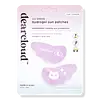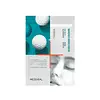What's inside
What's inside
 Key Ingredients
Key Ingredients

 Benefits
Benefits

 Concerns
Concerns

 Ingredients Side-by-side
Ingredients Side-by-side

Water
Skin ConditioningGlycerin
HumectantSodium Polyacrylate
AbsorbentNiacinamide
Smoothing1,2-Hexanediol
Skin ConditioningCarbomer
Emulsion StabilisingPropanediol
SolventPvp
Emulsion StabilisingTartaric Acid
BufferingAluminum Glycinate
AstringentPentylene Glycol
Skin ConditioningButylene Glycol
HumectantAdenosine
Skin ConditioningGlyceryl Caprylate
EmollientDisodium EDTA
Glycyrrhiza Glabra Root Extract
BleachingPolygonum Cuspidatum Root Extract
AntioxidantCentella Asiatica Extract
CleansingCamellia Sinensis Leaf Extract
AntimicrobialHydrolyzed Collagen
EmollientAloe Barbadensis Leaf Juice Powder
Skin ConditioningScutellaria Baicalensis Root Extract
AstringentChamomilla Recutita Flower Extract
MaskingRosmarinus Officinalis Leaf Extract
AntimicrobialChondrus Crispus Powder
AbrasiveGlucomannan
Skin ConditioningCeratonia Siliqua Gum
EmollientDextrin
AbsorbentWater, Glycerin, Sodium Polyacrylate, Niacinamide, 1,2-Hexanediol, Carbomer, Propanediol, Pvp, Tartaric Acid, Aluminum Glycinate, Pentylene Glycol, Butylene Glycol, Adenosine, Glyceryl Caprylate, Disodium EDTA, Glycyrrhiza Glabra Root Extract, Polygonum Cuspidatum Root Extract, Centella Asiatica Extract, Camellia Sinensis Leaf Extract, Hydrolyzed Collagen, Aloe Barbadensis Leaf Juice Powder, Scutellaria Baicalensis Root Extract, Chamomilla Recutita Flower Extract, Rosmarinus Officinalis Leaf Extract, Chondrus Crispus Powder, Glucomannan, Ceratonia Siliqua Gum, Dextrin
Water
Skin ConditioningGlycerin
HumectantSodium Polyacrylate
AbsorbentDipropylene Glycol
HumectantPolyacrylic Acid
Emulsion StabilisingNiacinamide
SmoothingAgar
MaskingHydroxyethyl Urea
HumectantHydroxyacetophenone
AntioxidantXanthan Gum
EmulsifyingCaprylyl Glycol
EmollientCellulose Gum
Emulsion StabilisingAluminum Glycinate
AstringentCetyl Ethylhexanoate
EmollientTartaric Acid
BufferingPentasodium Triphosphate
BufferingCaprylyl/Capryl Glucoside
CleansingAdenosine
Skin ConditioningDipotassium Glycyrrhizate
HumectantSodium Ascorbyl Phosphate
AntioxidantGlutathione
Madecassoside
Antioxidant1,2-Hexanediol
Skin ConditioningCentella Asiatica Leaf Extract
Skin ConditioningSodium Hyaluronate
HumectantCentella Asiatica Extract
CleansingPotassium Hyaluronate
Skin ConditioningSodium Hyaluronate Crosspolymer
HumectantHydrolyzed Sodium Hyaluronate
Skin ConditioningHyaluronic Acid
HumectantSodium Acetylated Hyaluronate
HumectantAsiaticoside
AntioxidantAsiatic Acid
Skin ConditioningMadecassic Acid
Skin ConditioningWater, Glycerin, Sodium Polyacrylate, Dipropylene Glycol, Polyacrylic Acid, Niacinamide, Agar, Hydroxyethyl Urea, Hydroxyacetophenone, Xanthan Gum, Caprylyl Glycol, Cellulose Gum, Aluminum Glycinate, Cetyl Ethylhexanoate, Tartaric Acid, Pentasodium Triphosphate, Caprylyl/Capryl Glucoside, Adenosine, Dipotassium Glycyrrhizate, Sodium Ascorbyl Phosphate, Glutathione, Madecassoside, 1,2-Hexanediol, Centella Asiatica Leaf Extract, Sodium Hyaluronate, Centella Asiatica Extract, Potassium Hyaluronate, Sodium Hyaluronate Crosspolymer, Hydrolyzed Sodium Hyaluronate, Hyaluronic Acid, Sodium Acetylated Hyaluronate, Asiaticoside, Asiatic Acid, Madecassic Acid
Ingredients Explained
These ingredients are found in both products.
Ingredients higher up in an ingredient list are typically present in a larger amount.
1,2-Hexanediol is a synthetic liquid and another multi-functional powerhouse.
It is a:
- Humectant, drawing moisture into the skin
- Emollient, helping to soften skin
- Solvent, dispersing and stabilizing formulas
- Preservative booster, enhancing the antimicrobial activity of other preservatives
Adenosine is in every living organism. It is one of four components in nucleic acids that helps store our DNA.
Adenosine has many benefits when used. These benefits include hydrating the skin, smoothing skin, and reducing wrinkles. Once applied, adenosine increases collagen production. It also helps with improving firmness and tissue repair.
Studies have found adenosine may also help with wound healing.
In skincare products, Adenosine is usually derived from yeast.
Learn more about AdenosineWe don't have a description for Aluminum Glycinate yet.
Centella Asiatica Extract (Centella) is derived from an herb native to Southeast Asia. It is famous for its anti-inflammatory and soothing properties.
Centella is rich in antioxidants and amino acids, such as Madecassic Acid and Asiaticoside.
Studies show the compounds in centella help with:
The combination of all these properties makes centella effective at soothing, hydrating, and protecting the skin.
Other great components of centella include Vitamin A, vitamin C, several B vitamins, and Asiatic Acid.
Fun fact: Centella has been used as a medicine and in food for many centuries. As a medicine, it is used to treat burns, scratches, and wounds.
Learn more about Centella Asiatica ExtractGlycerin is already naturally found in your skin. It helps moisturize and protect your skin.
A study from 2016 found glycerin to be more effective as a humectant than AHAs and hyaluronic acid.
As a humectant, it helps the skin stay hydrated by pulling moisture to your skin. The low molecular weight of glycerin allows it to pull moisture into the deeper layers of your skin.
Hydrated skin improves your skin barrier; Your skin barrier helps protect against irritants and bacteria.
Glycerin has also been found to have antimicrobial and antiviral properties. Due to these properties, glycerin is often used in wound and burn treatments.
In cosmetics, glycerin is usually derived from plants such as soybean or palm. However, it can also be sourced from animals, such as tallow or animal fat.
This ingredient is organic, colorless, odorless, and non-toxic.
Glycerin is the name for this ingredient in American English. British English uses Glycerol/Glycerine.
Learn more about GlycerinNiacinamide is a multitasking form of vitamin B3 that strengthens the skin barrier, reduces pores and dark spots, regulates oil, and improves signs of aging.
And the best part? It's gentle and well-tolerated by most skin types, including sensitive and reactive skin.
You might have heard of "niacin flush", or the reddening of skin that causes itchiness. Niacinamide has not been found to cause this.
In very rare cases, some individuals may not be able to tolerate niacinamide at all or experience an allergic reaction to it.
If you are experiencing flaking, irritation, and dryness with this ingredient, be sure to double check all your products as this ingredient can be found in all categories of skincare.
When incorporating niacinamide into your routine, look out for concentration amounts. Typically, 5% niacinamide provides benefits such as fading dark spots. However, if you have sensitive skin, it is better to begin with a smaller concentration.
When you apply niacinamide to your skin, your body converts it into nicotinamide adenine dinucleotide (NAD). NAD is an essential coenzyme that is already found in your cells as "fuel" and powers countless biological processes.
In your skin, NAD helps repair cell damage, produce new healthy cells, support collagen production, strengthen the skin barrier, and fight environmental stressors (like UV and pollution).
Our natural NAD levels start to decline with age, leading to slower skin repair, visible aging, and a weaker skin barrier. By providing your skin niacinamide, you're recharging your skin's NAD levels. This leads to stronger, healthier, and younger looking skin.
Another name for vitamin B3 is nicotinamide. This vitamin is water-soluble and our bodies don't store it. We obtain Vitamin B3 from either food or skincare. Meat, fish, wheat, yeast, and leafy greens contain vitamin B3.
The type of niacinamide used in skincare is synthetically created.
Learn more about NiacinamideSodium Polyacrylate is the sodium salt of polyacrylic acid. It is used as an absorber, emollient, and stabilizer.
This ingredient is a super-absorbent polymer - meaning it can absorb 100 to 1000 times its mass in water. As an emollient, Sodium Polyacrylate helps soften and soothe skin. Emollients work by creating a barrier to trap moisture in. This helps keep your skin hydrated.
Tartaric acid is an AHA with exfoliating and antioxidant properties. It is found in many fruits, such as tamarind, grapes, bananas, and avocados.
AHAs provide chemical exfoliation, helping to improve skin tone and texture.
Tartaric acid is not as well studied as other AHAs, such as glycolic acid.
Learn more about Tartaric AcidWater. It's the most common cosmetic ingredient of all. You'll usually see it at the top of ingredient lists, meaning that it makes up the largest part of the product.
So why is it so popular? Water most often acts as a solvent - this means that it helps dissolve other ingredients into the formulation.
You'll also recognize water as that liquid we all need to stay alive. If you see this, drink a glass of water. Stay hydrated!
Learn more about Water